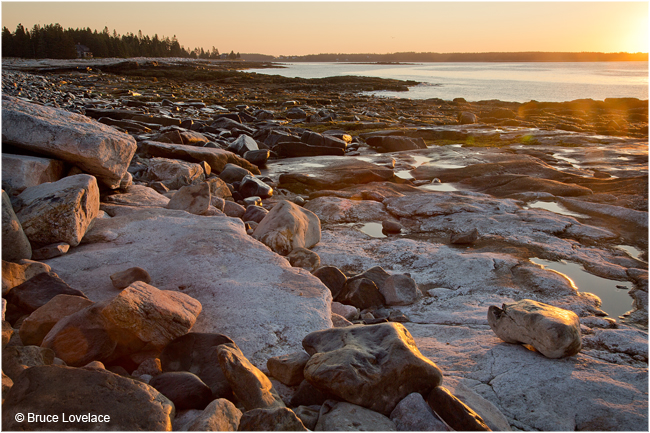
3 Days to Photograph Mount Desert Island
by Bruce Lovelace
March 16, 2014

I was a man on a mission. I only had 5 days allotted to photograph Mount Desert Island in Acadia National Park in Maine. It had been over 30 years ago, when as a young boy, I had scrambled on those amazing rocks on the eastern shore of the island.
I don't know what it is about this special place, but it taps a strong emotional response in me. I felt compelled to return. It's a full day's car ride to the “Down east” part of Maine from New Jersey. With two full days of travel, that left me with 3 days for photography and hiking. Not an abundance of time for sure, but I planned it carefully to get the most out of my short photo excursion.
I am more of a camper/hiker than a hotel/motel guy, so I reserved a campsite near the Bass Harbor Lighthouse at the southernmost tip of the island. I removed the seats from my minivan, packed up camping and camera gear and up the New Jersey Turnpike I sped. One of my favorite images presented itself shortly after my afternoon arrival in Maine that first day as I took a short walk to the Bass Harbor Lighthouse in the fog. I found a short trail heading north along the coast toward a popular photographer's vantage point for the lighthouse, but I took the path less traveled and strayed to the left.
I came across a mystical wooded scene of logs, roots, and a moss-covered carpet visually leading to an imaginary passageway into the fog-shrouded forest. It was a surreal and ghostly quiet setting with only the occasional muffled chime from a distant buoy bobbing in the ocean waves. I knew I was in for a special trip.
It is a unique and sometimes lonely experience for the landscape photographer who finds such a joy in witnessing the wonders of nature in person and can only share it with through his photography.
My first full day on the island ended with a photo of the Bass Harbor Lighthouse from the south, a photo that involved an adventuresome navigation through the thicket and a relentless assault from a swarm of hungry mosquitoes.
I hiked several of the lesser-travelled mountain trails, sometimes without seeing any other human beings for 20 minutes or more at a time. I visited several of the harbors, the lobster wharfs and even drove the normally crowded Park Loop Road and had no issues with crowds. My secret? I visited this photographer's paradise after Labor Day when summer vacationers are back to work. It is also a great time to visit Acadia because the days are pleasantly warm and the nights are fittingly chilly.
The major highlight of my trek northward was that I was able to return to a friend’s ocean-front property, southward down the east coast on the island about 4 miles from Bar Harbor. I feel that any words I try to use will fall short, but I describe this unique place as remarkable and magical in nature. I visited this location each day at a different time and took more photos here than any other spot on the island during my stay.
There was nothing to hear but the sound of the crashing waves. A great view of the ocean, the limitless sky, the dynamic clouds, the variety of trees, and those majestic granite rocks combine together in an arrangement of shapes, textures and colors that truly excite a nature photography geek like me.
I like to travel lightly during my photography expeditions. The camera equipment I carry is what I consider to be minimal. In addition to the little gadgets like shutter cords, memory cards, lens wipes, filters, and batteries, here is my list of equipment used:
- Canon 5D and 5D Mark III bodies - You always have to have a back-up.
- Canon 24-105mm f4.0 Lens – Versatile and plenty wide enough for most landscape photography.
- Canon 400mm f5.6 Lens-Used sparingly to capture images of a few small critters.
- Canon 70-200mm f2.8 Lens – Did not use much but it is a good bridge between the 24-105 and the 400.
- Rocketfish RF-TRP-47C carbon fiber tripod -very light and sturdy enough if I am careful.
- Waist-level belly-bag- My 5D Mark III and 24-105mm fit in and it's great for quick access while hiking.
- Small backpack to carry spare lenses, clothing, food, trail maps, books and notebook.
The other components that made this photography and hiking adventure a great success were planning.
I researched for the best time of the year, the typical weather patterns and even the phase of the moon for night photography. I visited several photography and Maine tourist web sites and purchased two guide books on photography and Acadia.
I shot over 400 images, many just slight variations of each other, and narrowed down to about 20 that I have shared with others. Although it is challenging to fully capture that emotional feeling in a photograph, the 3 Days to Photograph Mount Desert Island adventure was a success. I derive satisfaction in creating some images that I and others can view and enjoy again and again.
Bruce Lovelace has been a portrait photographer for over 30 years and a wannabe nature photographer forever. He blogs about digital photography tips and hikes with a camera or two when time permits.
www.better-digital-photo-tips.com
www.canoncamerageek.com
brucelovelace@verizon.net
Google Map Showing Mount Desert Island off Maine
View Larger Map
[ Top ]










